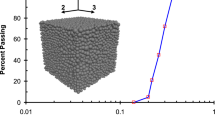Abstract
In this work, a viscoelastic model was applied to describe the evolution of molecular orientation in injection molding. This model is an evolution of a previously applied nonlinear Maxwell model, in which the relaxation time was allowed to depend on a structural parameter rather than on shear rate as considered in our previous works. The parameter chosen was the difference between the two main eigenvalues of the molecular conformation tensor. The model was applied to some injection molding tests carried out on an amorphous PS. The results in terms of orientation were discussed, also in comparison with the results of the previous model in which relaxation time depended on shear rate. It was found that, apart from being much sounder on a physical basis, the model also introduces improvements on the description of experimental data.






Similar content being viewed by others
References
Balzano L, Rastogi S, Peters GWM (2008) Flow induced crystallization in isotactic polypropylene-1,3:2,4-bis(3,4-dimethylbenzylidene)sorbitol blends: implications on morphology of shear and phase separation. Macromolecules 41:399–408
Cao W, Shen C, Zhang C, Wang L (2008) Computing flow-induced stresses of injection molding based on the Phan–Thien–Tanner model. Arch Appl Mech 78(3):363–377
Coccorullo I, Pantani R, Titomanlio G (2008) Spherulitic nucleation and growth rates in an iPP under continuous shear flow. Macromolecules 41:9214–9223
De Santis F, Pantani R, Speranza V, Titomanlio G (2010) Analysis of shrinkage development of a semicrystalline polymer during injection molding. Ind Eng Chem Res 49(3):2469–2476
Douven L, Baaijens F, Meijer HEH (1995) Computation of properties of injection-molded products. Prog Polym Sci 20(2):403–457
Housmans J-W, Balzano L, Santoro D, Peters GWM, Meijer HEH (2009) A design to study flow induced crystallization in a multipass rheometer. Int Polym Process 24(2):185–197
Isayev A, Lin T (2010) Frozen-in birefringence and anisotropic shrinkage in optical moldings: I. Theory and simulation scheme. Polymer 51:316–327
Isayev AI, Hieber CA (1980) Toward a viscoelastic modeling of the injection molding of polymers. Rheol Acta 19:168–182
Janeschitz K, Ratajski E, Stadlbauer M (2003) Flow as an effective promotor of nucleation in polymer melts: a quantitative evaluation. Rheol Acta 42:355–364
Jansen K, Pantani R, Titomanlio G (1998) As-molded shrinkage measurements on polystyrene injection molded products. Polym Eng Sci 38(2):254–264
Kuhn W, Grun F (1942) Relation between the elasticity constant and extension double diffraction of highly elastic substances. Kolloid-Z 101:248–271
Kwon K, Isayev A, Kim K, Van Sweden C (2006) Theoretical and experimental studies of anisotropic shrinkage in injection moldings of semicrystalline polymers. Polym Eng Sci 46:712–728
Mavridis H, Hrymak AN, Vlachopoulos J (1988) The effect of fountain flow on molecular orientation in injection molding. J Rheol 32(4):639–663
Pantani R (2003) Pressure and cooling rate-induced densification of atactic polystyrene. J Appl Polym Sci 89:184–190
Pantani R (2005) Validation of a model to predict birefringence in injection molding. Eur Polym J 41(5):1484–1492
Pantani R, Balzano L, Peters GWM (2011) Flow-induced morphology of iPP solidified in a shear device. Macromol Mater Eng 297:60–67
Pantani R, Coccorullo I, Speranza V, Titomanlio G (2005) Modeling of morphology evolution in the injection molding process of thermoplastic polymers. Prog Polym Sci 30(10):1185–1222
Pantani R, Coccorullo I, Speranza V, Titomanlio G (2007) Morphology evolution during injection molding: effect of packing pressure. Polymer 48(7):2778–2790
Pantani R, Coccorullo I, Volpe V, Titomanlio G (2010) Shear-induced nucleation and growth in isotactic polypropylene. Macromolecules 43:9030–9038
Pantani R, Sorrentino A, Speranza V, Titomanlio G (2004) Molecular orientation in injection molding: experiments and analysis. Rheol Acta 43(2):109–118
Pantani R, Sorrentino A, Speranza V, Titomanlio G (2012) Process-induced morphology distribution in injection molded syndiotactic polystyrene samples. Ind Eng Chem Res 51:10840–10847
Pantani R, Sorrentino A (2005) Pressure effect on viscosity for atactic and syndiotactic polystyrene. Polym Bull 54:365–376
Pantani R, Speranza V, Titomanlio G (2001a) Relevance of crystallisation kinetics in the simulation of the injection molding process. Int polym Process 16(1):61–71
Pantani R, Speranza V, Titomanlio G (2001b) Relevance of mold-induced thermal boundary conditions and cavity deformation in the simulation of injection molding. Polym Eng Sci 41(9):2022–2035
Pantani R, Speranza V, Sorrentino A, Titomanlio G (2002) Molecular orientation and strain in injection moulding of thermoplastics. Macromol Symp 185:293–307
Pantani R, Titomanlio G (1999) Volume relaxation and final product density in injection molding. Int J Form Process 2:211–224
Sadeghi S, Nazockdast H, Mehranpour M (2012) The birefringence and anisotropic planar shrinkage of polycarbonate/organoclay injection moldings. Polym Eng Sci 52(8):2182–2195
Sorrentino A, Pantani R (2009) Pressure-dependent viscosity and free volume of atactic and syndiotactic polystyrene. Rheol Acta 48:467–478
Souvaliotis A, Beris AN (1992) An extended White-Metzner viscoelastic fluid model based on an internal structural parameter. J Rheol 36:241–271
Speranza V, Pantani R, Besana G, Titomanlio G (2007) Anisotropic shrinkage of injection molded poly vinylidene fluoride samples. Polym Eng Sci 47(9):1788–1795
Steenbakkers RJA, Peters GWM (2011) A stretch-based model for flow-enhanced nucleation of polymer melts. J Rheol 55:401–433
Swartjes F, Peters GWM, Rastogi S, Meijer HEH et al (2003) Stress induced crystallization in elongational flow. Int Polym Proc 18:53–66
Vietri U, Sorrentino A, Speranza V, Pantani R (2011) Improving the predictions of injection molding simulation software. Polym Eng Sci 51(10):2542–2551
Watanabe K, Suzuki T, Masubuchi Y, Taniguchi T, Takimoto J, Koyama K (2003) Crystallization kinetics of polypropylene under high pressure and steady shear flow. Polymer 44(19):5843–5849
Author information
Authors and Affiliations
Corresponding author
Rights and permissions
About this article
Cite this article
Pantani, R., Speranza, V. & Titomanlio, G. Orientation distribution in injection molding: a further step toward more accurate simulations. Rheol Acta 51, 1041–1050 (2012). https://doi.org/10.1007/s00397-012-0660-8
Received:
Revised:
Accepted:
Published:
Issue Date:
DOI: https://doi.org/10.1007/s00397-012-0660-8




